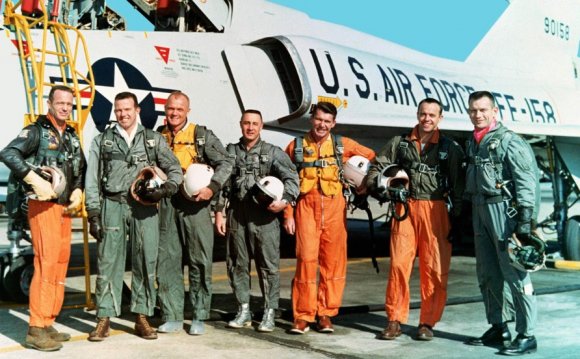
 Pick up your iPhone. Hold it in the palm of your hand and look at it for a good, long minute. And then contemplate this:
Pick up your iPhone. Hold it in the palm of your hand and look at it for a good, long minute. And then contemplate this:
There is more computing power in your iPhone than in the technology that took America's first astronauts to the moon.
So writes Lily Koppel in her New York Times best seller The Astronaut Wives Club, which premiers as a television series Thursday night on ABC. I couldn't resist this book when it came out two years ago, as my childhood and adolescence played out against the news footage of the Cold War, the Atomic Age and the Space Race. Among my where-were-you-when memories is sitting in our living room with my father watching Neil Armstrong walk on the moon.
Before that, I remember a lot of fuss made over something Russia launched called Sputnik which meant they were first in space and how we needed more science in our schools. Later it was news footage of the Florida beach where wives stood with their families and friends and other Americans to witness their husbands pushed into space by mega-ton, fiery rockets. Everything about these women and their lives seemed perfect.
Which is exactly how NASA insisted they be. Each of them was investigated, their lives scrutinized, as their test pilot husbands underwent screening and testing as candidates for that elite group, America's first spacemen. NASA believed a stable home life and happy marriage was critical to the success of the astronauts.
The original seven were chosen in April of 1959 and known as the Mercury Seven, with groups of Gemini and Apollo astronauts chosen in 1962 and 1963. Koppel describes these seven wives as America's first reality stars.
I'm sure there will be inevitable comparisons of this group to Bravo's Real Housewives franchise. But the women of The Astronaut Wives Club carry far more grace and class than any of them have ever exhibited on their many shows. Whereas the lives of Bravo "housewives" are mired in drama that consistently fractures each other, their "friendships", their families, and even themselves, the wives of the Mercury Seven closed ranks in order to protect each other and their families. Together they learned to handle the incredible pressures that came with intense press coverage of everything they did.
NASA had unwritten rules for its astronauts. Happy marriages and stable home lives were considered essential to their success in space. Wives needed to be poised and able to withstand public scrutiny. America stood on the threshold of the Space Age, and NASA saw these women as representing the ideals of the modern, American wife of that time. This meant NASA wanted to know how patriotic they were, how much they drank, how often they cooked, and whether or not they'd had any contact with communists.
The wives did have their secrets and flaws. Koppel tells the story of how Marge Slayton, wife of Deke, concealed the fact that he was her second husband and had been divorced. There was no room for divorce in the lives of their astronauts.
Trudy Cooper, married to Gordo, had left him after 12 years of marriage, due to his philandering. He'd aced all his screening tests (psychiatrists chalked up his affairs to having a healthy, male appetite), but in order to be accepted, he needed a wife. She came back to him.
Alan Shepard, who was the first American in space, ended up as the philanderer of the Mercury Seven, and openly so. His wife Louise looked the other way, because she knew he really loved her.
As wives of test pilots, they had lived with the daily fear that their husbands might not return home. The death rate among test pilots could be as high as two pilots a week. They had endured long separations from their husbands during their many deployments. They had lived in sparse military housing on about $7, 000 a year.
All of this prepared them well for when they were thrust into the national spotlight. The Mercury Seven had barely been presented when the wives found the press at their doorsteps. Reporters camped out on their lawns and peered into their windows. They walked into their homes unannounced, found them in the supermarket aisle or at the local pool where they had taken their children, and then peppered them with personal questions.
As the space program got underway, the wives moved off their Navy and Air Force military base into a subdivision of tract homes where they ended up as neighbors. While NASA had plenty of standards and expectations for them, they offered the wives no means for upholding them. So the constructed their own support system and made their own traditions that saw them through these years.
Their tradition of gathering in the home of the wife whose astronaut-husband was next shooting through space became the cornerstone of that support. It evolved over potluck dishes carried to the astronaut wife's home, the table laden with the foods of that time: casseroles, Jell-O molds, deviled eggs, chocolate chip cookies and moon pies. And the astronaut wives always popped open champagne for the celebrations that followed splash-downs.
Plan on watching the show? The early 1960s vibe of The Astronaut Wives Club could fill the void left by the Mad Men finale. Channel your inner housewife by serving deviled eggs (apparently a potluck favorite) and chocolate chip cookies (Annie Glenn's recipe was published in newspapers and quite popular during this time).
You should also sip champagne, in coupe glasses, of course. Those shallow, saucer-shaped stems were popular in the 60s before fluted glasses came into style. (And if burping is ever an issue for you when you imbibe the bubbly, the broader shape of the glass means less carbonation in the champagne, which means fewer burps.)
One last note. If you haven't been to the Adler Planetarium recently, go. Its Shoot for the Moon exhibit has been completely refurbished and expanded and is now called Mission Moon. The Gemini 12 capsule from which Jim Lovell and Buzz Aldrin tested new spacewalk techniques is still on display, but it's been reconfigured, so you can now see down into it and walk all around it. You will be amazed at its size. It's truly mind-boggling to think how that tiny capsule was home to two men as they worked in space for four days.
And while you're looking at it, with its 200+ switches and dials, hold your cell phone and think about how much more technology we have now in the palms of our hands than the men who blasted thousands of miles into the dark corners of outer space.
RELATED VIDEO












